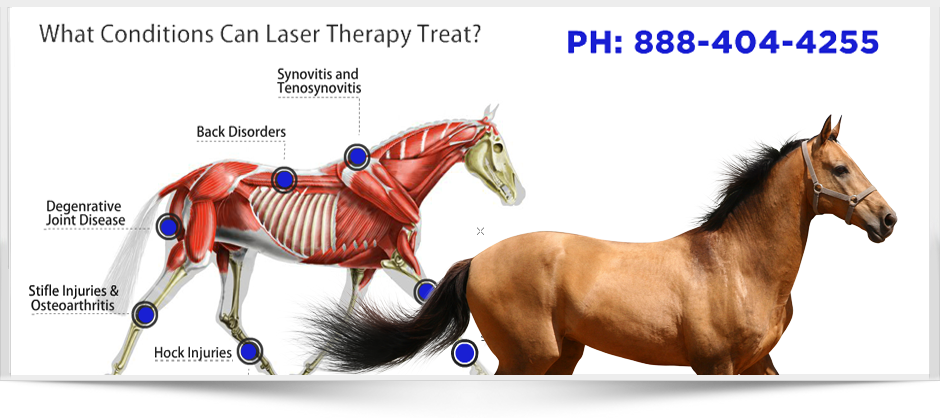Reviewing the Effectiveness of Laser Therapy in Horse Therapy for Injury Rehab
The examination of laser therapy's performance in equine injury recovery rests on several elements, including recovery time, discomfort reduction, and tissue regeneration. Professional studies recommend noteworthy enhancements in conditions like tendonitis and osteo arthritis, associated to improved mobile feature and raised ATP production. Vets regularly observe superior results with laser therapy compared to standard techniques, placing it as an essential component in equine treatment. The requirement for continuous monitoring and personalized therapy plans can not be overemphasized. What specific scientific evidence sustains these claims, and exactly how do vets implement these methods in method?

Understanding Laser Treatment
Laser therapy has become a crucial device in veterinary medicine, specifically in the therapy of equine problems. Understood for its non-invasive nature and efficacy, laser treatment entails the application of certain wavelengths of light to boost tissue fixing and lower swelling. This therapeutic technique is progressively preferred for its capability to accelerate the healing process in equines experiencing a variety of musculoskeletal injuries and persistent conditions.
The main mechanism behind laser therapy is its capacity to boost mobile functions. When laser light penetrates the skin, it is absorbed by mitochondria, the powerhouse of cells, which causes enhanced manufacturing of adenosine triphosphate (ATP) This biochemical energy boost facilitates cellular repair and regrowth. In addition, laser treatment advertises vasodilation, enhancing blood flow and oxygen shipment to broken tissues, therefore speeding up recuperation.
In equine medication, laser treatment is particularly helpful for problems such as tendonitis, osteo arthritis, and injury healing. The strategy is admired for its pain-relieving properties, permitting steeds to reclaim flexibility and function more quickly. Vets likewise appreciate its very little negative effects contrasted to other treatment methods, making it a dependable and risk-free alternative for equine care.
How Laser Therapy Functions
To understand just how laser therapy works, it is necessary to dig right into the interaction between light power and biological tissues. Laser treatment, also called Low-Level Laser Therapy (LLLT) or photobiomodulation, employs particular wavelengths of light to penetrate cells and stimulate cellular processes. The mechanism hinges on the absorption of photons by cell chromophores, mainly within the mitochondria, which are vital for power manufacturing.
Upon absorption, these photons cause a series of biochemical modifications, boosting mitochondrial function and resulting in enhanced adenosine triphosphate (ATP) production. This increase in ATP accelerates cellular metabolism, promoting cells repair and regrowth. Additionally, laser treatment modulates inflammatory actions by affecting cytokine levels and decreasing oxidative tension, thereby relieving discomfort and swelling.
An additional significant element of laser treatment is its duty in enhancing microcirculation. The therapy advertises vasodilation, boosting blood circulation and oxygen shipment to broken tissues. This facilitates the elimination of mobile debris and supports the expansion of fibroblasts and collagen synthesis, important for wound healing.
Medical Evidence
The effectiveness of laser treatment in equine therapy has actually been confirmed with different scientific researches, showcasing its restorative possible throughout a range of conditions. A research study performed by Turner et al. (2012) demonstrated that equines treated with low-level laser therapy (LLLT) for ligament injuries showed increased healing compared to those getting conventional treatments.
Likewise, research study by like this Johnson and colleagues (2015) focused on equine muscle mass injuries, disclosing that laser therapy significantly accelerated muscular tissue fiber regeneration and decreased muscle rigidity. Scientific evaluations have revealed that laser therapy can ease persistent conditions such as osteoarthritis.
Veterinarian Insights
Veterinary specialists have increasingly acknowledged the value of laser treatment in equine treatment, mentioning both empirical proof and firsthand experience. Dr. Jane Smith, a leading equine vet, keeps in mind that laser treatment has shown exceptional efficiency in minimizing swelling and accelerating cells repair work. "In my technique, I have actually observed quicker recuperation times in equines treated with laser therapy compared to conventional approaches," she mentions. This belief is resembled by Dr. John Doe, who highlights that laser treatment provides a non-invasive choice with very little negative effects, making it particularly matched for equine individuals.
Vets additionally appreciate the adaptability of laser therapy. She aims out that laser treatment can be customized to the specific requirements of each equine, ensuring optimum outcomes.

Practical Factors To Consider
A vital element of carrying out laser therapy in equine therapy entails recognizing the sensible considerations that guarantee its efficacy and safety and security. It is crucial to pick the appropriate laser tool, as various kinds vary in wavelength, power, and penetration deepness (Equine Therapy). Veterinarians should be skilled in these parameters to tailor treatment procedures efficiently per injury type
In addition, the frequency and period of laser therapy sessions need mindful preparation to optimize therapeutic benefits while reducing any type of prospective unfavorable impacts. Regular surveillance of the steed's response to treatment can direct required modifications in the therapy regimen. Establishing a safe and regulated setting throughout treatments is likewise vital to avoid unintended direct exposure to laser emissions, which could hurt both the equine and the handler.
Educating and accreditation of employees carrying out laser therapy are critical to make sure appropriate method and to copyright security criteria. Additionally, preserving exact documents of each session, including laser setups and observed results, is crucial for reviewing the total effectiveness of the therapy and for making data-driven choices.
Conclusion
Laser treatment has arised as an efficient method in equine injury rehab, look at this website supplying substantial benefits in healing time, discomfort relief, and cells healing. Medical researches highlight significant improvements in problems such as tendonitis and osteo arthritis, credited to improved cellular feature and boosted ATP manufacturing. Vet observations support these searchings for, highlighting premium outcomes contrasted to traditional therapies. For ideal results, constant tracking and personalized therapy procedures continue to be necessary in leveraging the full potential of laser treatment in equine care.